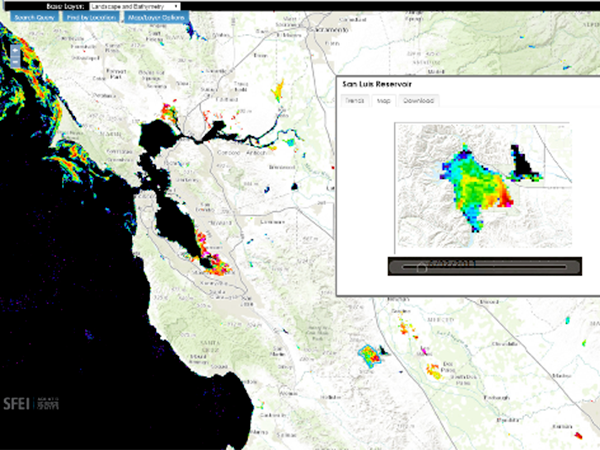Building a framework for an integrated HAB detection and monitoring system in San Francisco Estuary
Over the last decade, harmful algal blooms (HABs) have emerged as one of the highest-priority water quality management issues in the San Francisco Estuary, which includes the San Francisco Bay (Bay) and Sacramento-San Joaquin River Delta (Delta). Although major HAB events in the Bay have historically been rare, recent studies have determined that multiple HAB species and their toxins are frequently detected, highlighting the potential for major HAB risks. In 2022, an unprecedented HAB event caused the first documented HAB-related fish kills and widespread low dissolved oxygen event in the Bay. In the Delta, harmful cyanobacterial blooms have occurred with increasing frequency and severity since they were first recorded in 1999.
While there have been major expansions in HAB-related research and monitoring in the Bay and Delta over the last decade, there is currently no sustained, coordinated program for monitoring HABs throughout the San Francisco Estuary.
Monitoring and Event Response for Harmful Algal Blooms (NOAA's MERHAB program)
NOAA recently announced that it is awarding a $3 million grant over 5 years, through the Monitoring and Event Response Research Program (MERHAB) to advance an integrated HAB detection and monitoring system across the San Francisco Estuary. The project, led by scientists at the San Francisco Estuary Institute (SFEI), U.S. Geological Survey (USGS), and California Department of Water Resources (DWR), will validate and refine HAB monitoring tools and technologies, develop monitoring program designs, and strategize a plan for implementing a robust regionally-funded estuary-wide HAB monitoring program. The project is a large collaborative effort with Co-Principal Investigators from UC Santa Cruz, Bend Genetics, and the San Francisco Bay and Central Valley Regional Water Quality Control Boards. Other key collaborators are from San Francisco Baykeeper, Cal State Maritime Academy, Restore the Delta, and NOAA-NCCOS. This team will leverage on-going research and monitoring activities to help enhance estuary-wide HAB monitoring.
Looking Ahead
By enhancing HAB-related measurements and leveraging and integrating data collected by the region’s water quality and HAB-focused programs, this project will strengthen our understanding of HAB drivers and ecology in the San Francisco Estuary.
This new information and understanding will support future decision-making related to HABs management and contribute to the long-term health of the San Francisco Estuary.
Expanded Harmful Algae Monitoring in the San Francisco Estuary
Improved monitoring will allow researchers to investigate HAB dynamics and equip local managers with the necessary information to respond to HABs and guide future management decisions to support San Francisco Estuary’s future resilience.
Major project components include:
- Enhancing existing monitoring data sources with new technologies and tools, including: remote sensing, continuous water quality sensors, molecular DNA-based methods, and community science monitoring
- Building an online HAB dashboard to provide managers with a decision-support-tool for HAB mitigation
- Improved understanding of HAB transport dynamics through sampling of toxins/HAB cells using multiple methods such as water grab samples, passive samplers (Solid Phase Adsorption Toxin Tracking samplers), shellfish, and molecular tools
- Convening a Management Transition Advisory Group (MaTag) composed of managers, regulators, and NGO stakeholders to develop a coordinated HAB strategy across the San Francisco Estuary and to identify how tools developed in the project can be transitioned into routine use by regionally-funded water quality monitoring programs.

Figure 1. Map of HAB and water quality related monitoring across the San Francisco Estuary including existing, on-going work combined with the new MERHAB activities.
If you have questions, we encourage you to contact our lead principal investigators:
David Senn ([email protected]), Keith Bouma-Gregson ([email protected]), and Ellen Preece ([email protected]).
Other Co-Principal Investigators and Collaborators include the following: Raphael Kudela (UC Santa Cruz), Tim Otten (Bend Genetics), Ariella Chelsky (SFEI), Tom Mumley and Kevin Lunde (San Francisco Bay Regional Water Quality Control Board), Meredith Howard (Central Valley Regional Water Quality Control Boards), Jon Rosenfield (San Francisco Baykeeper), Ivan Senock and Spencer Fern (Restore the Delta), and Marc Suddleson (Program Manager, NOAA-NCCOS).
For additional information about this NOAA-funded project, see the press release from NOAA and the portable one-page project description.
Dates:
2023 to 2028
Associated Staff:
Keith Bouma-Gregson, USGS
Ellen Preece, DWR
Raphael Kudela, UCSC
Meredith Howard, Central Valley Regional Water Quality Control Board
Tom Mumley, San Francisco Regional Water Quality Control Board
Ian Wren, SF Baykeeper
Jon Rosenfeld, SF Baykeeper
Spencer Fern, Restore the Delta
Alex Parker Cal State Maritime Academy
Tim Otten, Bend Genetics
Programs and Focus Areas:
Nutrients
Software Engineering




















